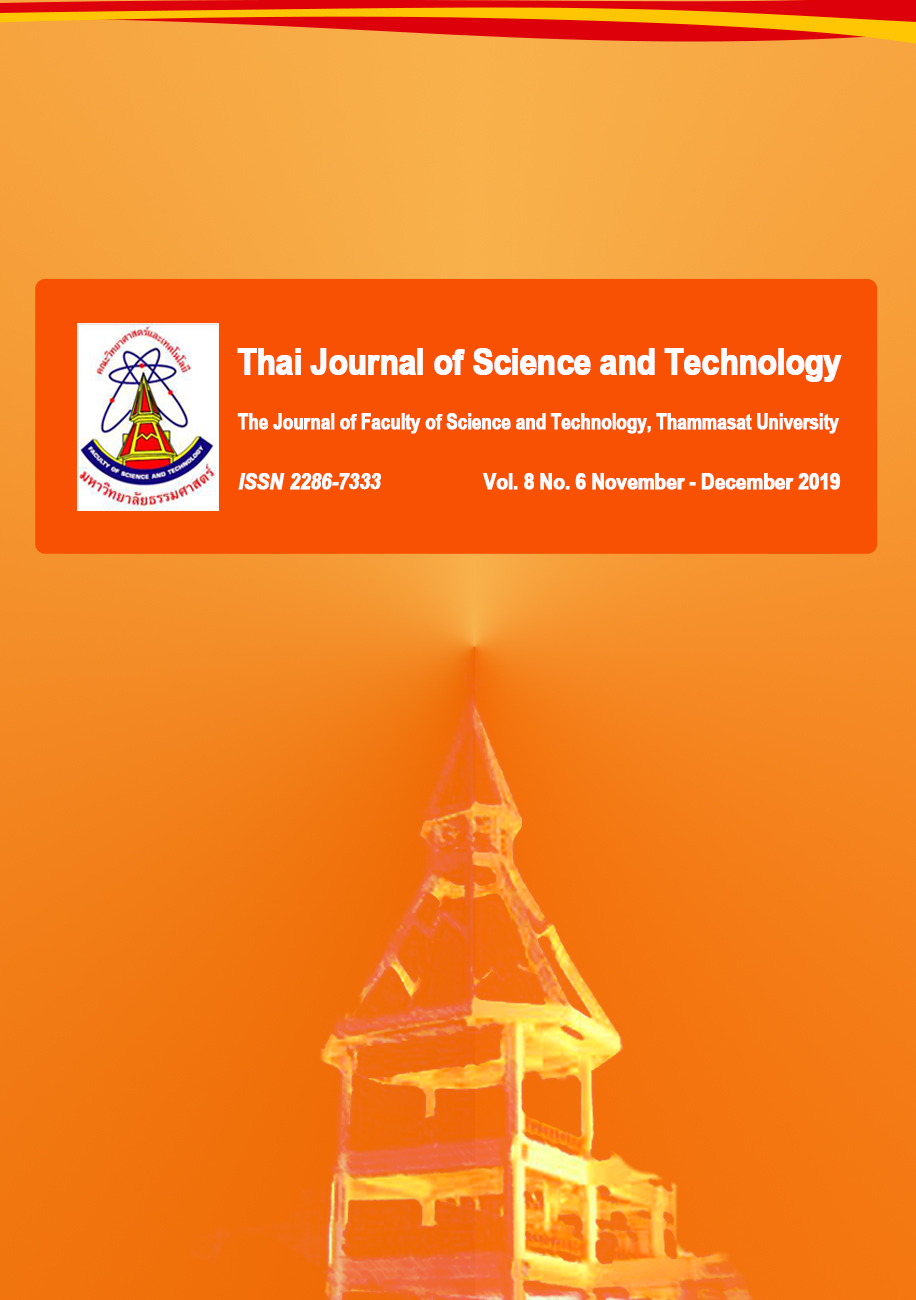การประเมินสภาพการขาดน้ำของไม้ประดับบางชนิดสำหรับสวนหลังคา
Main Article Content
Abstract
Abstract
“Green roof” is a considerable solution to increase urban green area. Plants cultivated on the rooftop inescapably encountering drought and severe heat conditions. This study aimed to evaluate the water-deficit tolerant ability of some ornamental plants for roof garden utility. Non-irrigated rooftop model was constructed in a greenhouse at Mahidol University, Nakhon Pathom province. Fifteen ornamental plants were observed under two conditions, i.e. watering and non-watering, for seven days. Water-deficit tolerant ability was evaluated by beauty scoring. Liriope muscari (Decne.) L.H. Bailey, Cyanotis obtusa (Trimen) Trimen and Allium schoenoprasum L. showed the high tolerance ability to water-deficit by seven days leading to be suitable plants for roof garden by watering once a week. Moreover, Pilea libanensis Urb. and Plectranthus scutellarioides (L.) R.Br. also had high tolerance by five days. The short period plants for three days were Eleocharis sp., Fimbristylis ovata (Burm.f.) J.Kern, Zephyranthes candida (Lindl.) Herb. and Pennisetum setaceum (Forssk.) Chiov., whereas Leucanthemum vulgare (Vaill.) Lam., Rhynchospora nervosa (Vahl.) Boeckeler, Acalypha wilkesiana MÜll.Arg., Trachelospermum jasminoides (Lindl.) Lem., Coreopsis rosea Nutt. and Achillea millefolium L. showed the lowest tolerant ability to water-deficit by one day and might not be utilized for green roof cultivation.
Keywords: drought tolerance plant; green roof; landscape
Article Details
บทความที่ได้รับการตีพิมพ์เป็นลิขสิทธิ์ของคณะวิทยาศาสตร์และเทคโนโลยี มหาวิทยาลัยธรรมศาสตร์ ข้อความที่ปรากฏในแต่ละเรื่องของวารสารเล่มนี้เป็นเพียงความเห็นส่วนตัวของผู้เขียน ไม่มีความเกี่ยวข้องกับคณะวิทยาศาสตร์และเทคโนโลยี หรือคณาจารย์ท่านอื่นในมหาวิทยาลัยธรรมศาสตร์ ผู้เขียนต้องยืนยันว่าความรับผิดชอบต่อทุกข้อความที่นำเสนอไว้ในบทความของตน หากมีข้อผิดพลาดหรือความไม่ถูกต้องใด ๆ
References
พชร เลิศปิติวัฒนา, 2556, การออกแบบสวนหลังคา, ว.ศิลปะสถาปัตยกรรมศาสตร์ มหาวิทยาลัยนเรศวร 6(2): 19-34.
พูนพิภพ เกษมทรัพย์, 2554, ชีววิทยา 2, โครงการตำราวิทยาศาสตร์และคณิตศาสตร์, มูลนิธิ สอวน., กรุงเทพฯ.
วรัปศร อัคนียุทธ, 2548, อิทธิพลของขนาดพื้นที่สีเขียวที่มีต่ออุณหภูมิอากาศและความชื้นสัมพัทธ์ในเขตเมือง, วิทยานิพนธ์ปริญญาโท, มหาวิทยาลัยเกษตรศาสตร์, กรุงเทพฯ.
หัตถ์ชัย กสิโอฬาร, 2559, การใช้พาโคลบิวทราโซลเพื่อชะลอการเจริญเติบโตของช่อดอก Guzmania “Lingulata”, ว.พืชศาสตร์สงขลานครินทร์ 3(4): 14-17.
Bass, B. and Baskaran B., 2003, Evaluating Rooftop and Vertical Gardens as an Adaptation Strategy for Urban Areas, Institute for Research and Construction, National Research Council, Canada.
Broussard, M.C., 2007, A Horticultural Study of Liriope and Ophiopogon: Nomenclature, Morphology, and Culture, LSU Doctoral Dissertations, Louisiana State University, United States.
Bruhl, J.J. and Wilson K.L., 2007, Towards a comprehensive survey of C3 and C4 photosynthetic pathways in Cyperaceae, Aliso 23: 99-148.
Chalker-Scott, L., 1999, Environmental significance of anthocyanins in plant stress responses, Photochem. Photobiol. 70: 1-9.
Dixon, R.A. and Paiva N.L., 1995, Stress-induced phenylpropanoid metabolism, Plant Cell 7: 1085-1097.
Domenghini, J.C., Bremer, D.J., Fry, J.D. and Davis, G.L., 2013, Prolonged drought and recovery responses of Kentucky bluegrass and ornamental groundcovers, Hort. Sci. 48: 1209-1215.
Dunnett, N. and Kingsbury, N., 2004, Planting Green Roofs and Living Walls, Timber Press, Oregon.
Field, T., Lee, D. and Holbrook, N., 2001, Why leaves turn red in autumn, the role of anthocyanins in senescing leaves of red-osier dogwood, Plant Physiol. 127: 566-574.
Fukui, E., 1969, The recent rise of temperature in Japan, Sci. Rep. Tokyo Kyoiku Daigaku A 10: 145-164.
Getter, K.L. and Rowe, D.B., 2006, The role of green roofs in sustainable development, Hort Sci. 41: 1276-1285.
Getter, K.L. and Rowe, D.B., 2008, Selecting Plants for Extensive Green Roofs in the United States, Michigan State University, United States.
Greeshma, G.M. and Murugan, K., 2015, Desiccation tolerance in artillery plant [Pilea microphylla (L.) Liebm]: A search, Int. Res. J. Environ. Sci. 4: 26-32.
Hughes, N.M., Neufeld, H.S. and Burkey, K.O., 2005, Functional role of anthocyanins in high-light winter leaves of the evergreen herb Galax urceolata, New Phytol. 168: 575-587.
Kirschstein, C., 1997, Drought tolerance of sedum species: Derived from the meaning of suction tension in the root part, City Green 46: 252-256.
Koehler, M., 2003, Plant survival research and biodiversity: Lessons from Europe, pp. 165-190, Proceedings of the 1st International Greening Rooftops for Sustainable Communities Conference, Chicago, Illinois.
Mechelen, C.V., 2015, Nature as a Template for a New Concept of Extensive Green Roofs, Agricultural Sciences, University of Avignon, English.
Medina, E., 1996, CAM and C4 plants in the humid tropics, Trop. Forest Plant Ecophysiol. 2: 56-88.
Merzlyak, M.N., Chivkunova, O.B., Solovchenko, A.E. and Naqvi, K.R., 2008, Light absorption by anthocyanins in juvenile, stressed, and senescing leaves, J. Exp. Bot. 59: 3903-3911.
Neill, S.O. and Gould, K.R., 2003, Anthocyanins in leaves: Light attenuators or antioxi dants?, Funct. Plant Biol. 30: 865-873.
Oke, T.R., 1982, The energetic basis of the urban heat island, Quart. J. Royal Meteorol. Soc. 108: 1-24.
Scholz-Barth, K., 2001, Green roofs: Stormwater management from the top down, Environ. Design Construction 4: 63-70.
Theodore, O., 1999, Roof Garden History Design and Construction. W.W Norton & Company, New York. U.S. Environmental Protection Agency. (n.d.). “Polluted Runoff (Nonprint Source Pollution): Managing Urban Runoff”. Available Source: http://www.epa.gov/owow/nps/facts/point7.htm, April 10, 2018.
Tun, P.Y. and Sia, A., 2005, A Pilot Green Roof Research Project in Singapore, National Parks Board, Singapore Botanic Gardens, Singapore.
Wadugodapitiya, A., Weeratunga, V., de Goonatilake, S.A., Chandranimal, D., Perera, N. and Asela, C., 2013, Insights into the biodiversity of the Sampur area in Trincomalee, p. 15, Occasional Papers of IUCN, Sri Lanka.


